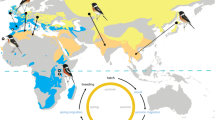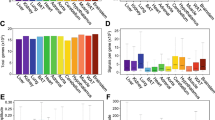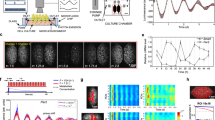Abstract
Period 2 (PER2) is a key component of the mammalian circadian clock machinery. In humans, genetic variation of clock genes or chronic disturbance of circadian rhythmicity has been implied in the onset of several phenotypes, ranging from periodic insomnias to advanced or delayed sleep phases, to more severe disorders. Peculiar geographic diversity patterns in circadian genes might represent an adaptive response to different light/dark cycles or environmental changes to which different human populations are exposed. To investigate the degree and nature of PER2 gene variation in human populations of different geographic origin, and its possible correlation with different latitudes, we sequenced a 7.7 kb portion of the gene in 20 individuals worldwide. In total, 25 variable sites were identified. The geographic distribution of haplotypes defined by five polymorphic sites was analyzed in 499 individuals from 11 populations from four continents. No evidence for latitude-driven selective effects on PER2 genetic variability was found. However, a high and significant difference in the geographic distribution of PER2 polymorphisms was observed between Africans and non-Africans, suggesting a history of geographically restricted natural selection at this locus. In support of this notion, we found several signals for selection in the sequences. The putative selected haplotype showed a recent coalescent age (8.7 Kyr), and an unusually high frequency in non-African populations. Overall, these findings indicate that a human clock-relevant gene, PER2, might have been influenced by positive selection, and offer preliminary insights into the evolution of this functional class of genes.
Similar content being viewed by others
Log in or create a free account to read this content
Gain free access to this article, as well as selected content from this journal and more on nature.com
or
References
Ko CH, Takahashi JS : Molecular components of the mammalian circadian clock. Hum Mol Genet 2006; 15: R271–R277.
Stratmann M, Schibler U : Properties, entrainment, and physiological functions of mammalian peripheral oscillators. J Biol Rhythms 2006; 21: 494–506.
Maywood ES, O'Neill J, Wong GKY, Reddy AB, Hastings MH : Circadian timing in health and disease. Prog Brain Res 2006; 153: 253–269.
Ebisawa T : Circadian rhythms in the CNS and peripheral clock disorders: human sleep disorders and clock genes. J Pharmacol Sci 2007; 103: 150–154.
Reppert SM, Weaver DR : Coordination of circadian timing in mammals. Nature 2002; 418: 935–941.
Pereira DS, Tufik S, Louzada FM et al: Association of the length polymorphism in the human Per3 gene with the delayed sleep-phase syndrome: does latitude have an influence upon it? Sleep 2005; 28: 29–32.
Nadkarni NA, Weale ME, von Schantz M, Thomas MG : Evolution of a length polymorphism in the human PER3 gene, a component of the circadian system. J Biol Rhythms 2005; 20: 490–499.
Fu L, Pelicano H, Liu J, Huang P, Lee CC : The circadian gene Period2 plays an important role in tumor suppression and DNA damage response in vivo. Cell 2002; 111: 41–50.
Hua H, Wang Y, Wan C et al: Circadian gene mPer2 overexpression induces cancer cell apoptosis. Cancer Sci 2006; 97: 589–596.
Ross K : Circadian rhythms play role in cancer research. J Natl Cancer Inst 2006; 98: 806–807.
Viswambharan H, Carvas JM, Antic V et al: Mutation of the circadian clock gene Per2 alters vascular endothelial function. Circulation 2007; 115: 2188–2195.
Spanagel R, Pendyala G, Abarca C et al: The clock gene Per2 influences the glutamatergic system and modulates alcohol consumption. Nat Med 2005; 11: 35–42.
Scozzari R, Cruciani F, Malaspina P et al: Differential structuring of human populations for homologous X and Y microsatellite loci. Am J Hum Genet 1997; 61: 719–733.
Bortolini M-C, Salzano FM, Thomas MG et al: Y-chromosome evidence for differing ancient demographic histories in the Americas. Am J Hum Genet 2003; 73: 524–539.
Cruciani F, La Fratta R, Santolamazza P et al: Phylogeographic analysis of haplogroup E3b (E-M215) Y chromosomes reveals multiple migratory events within and out of Africa. Am J Hum Genet 2004; 74: 1014–1022.
The Chimpanzee Sequencing and Analysis Consortium: Initial sequence of the chimpanzee genome and comparison with the human genome. Nature 2005; 437: 69–87.
Excoffier L, Slatkin M : Maximum-likelihood estimation of molecular haplotype frequencies in a diploid population. Mol Biol Evol 1995; 12: 921–927.
Excoffier L, Laval G, Schneider S : Arlequin (version 3.0): an integrated software package for population genetics data analysis. Evol Bioinformatics Online 2005; 1: 47–50.
Lewontin RC : The interaction of selection and linkage. I. General considerations; heterotic models. Genetics 1964; 49: 49–67.
Excoffier L, Smouse PE, Quattro JM : Analysis of molecular variance inferred from metric distances among DNA haplotypes: application to human mitochondrial DNA restriction data. Genetics 1992; 131: 479–491.
Weir BS, Cardon LR, Anderson AD, Nielsen DM, Hill WG : Measures of human population structure show heterogeneity among genomic regions. Genome Res 2005; 15: 1468–1476.
Nei M : Molecular Evolutionary Genetics. New York: Columbia University Press, 1987.
Tajima F : Statistical method for testing the neutral mutation hypothesis by DNA polymorphism. Genetics 1989; 123: 585–595.
Fu Y-X, Li W-H : Statistical tests of neutrality of mutations. Genetics 1993; 133: 693–709.
Fay JC, Wu C-I : Hitchhiking under positive Darwinian selection. Genetics 2000; 155: 1405–1413.
Forster P, Harding R, Torroni A, Bandelt H-J : Origin and evolution of Native American mtDNA variation: a reappraisal. Am J Hum Genet 1996; 59: 935–945.
Saillard J, Forster P, Lynnerup N, Bandelt H-J, Nørby S : mtDNA variation among Greenland Eskimos: the edge of the Beringian expansion. Am J Hum Genet 2000; 67: 718–726.
Patterson N, Richter DJ, Gnerre S, Lander ES, Reich D : Genetic evidence for complex speciation of humans and chimpanzees. Nature 2006; 441: 1103–1108.
Bandelt H-J, Forster P, Röhl A : Median-joining networks for inferring intraspecific phylogenies. Mol Biol Evol 1999; 16: 37–48.
Takahata N : Allelic genealogy and human evolution. Mol Biol Evol 1993; 10: 2–22.
Kimura M, Ohta T : The age of a neutral mutant persisting in a finite population. Genetics 1973; 75: 199–212.
Kivisild T, Reidla M, Metspalu E et al: Ethiopian mitochondrial DNA heritage: tracking gene flow across and around the Gate of Tears. Am J Hum Genet 2004; 75: 752–770.
Lovell A, Moreau C, Yotova V et al: Ethiopia: between sub-Saharan Africa and western Eurasia. Ann Hum Genet 2005; 69: 275–287.
Akey JM, Zhang G, Zhang K, Jin L, Shriver MD : Interrogating a high-density SNP map for signatures of natural selection. Genome Res 2002; 12: 1805–1814.
The International HapMap Consortium: A haplotype map of the human genome. Nature 2005; 437: 1299–1320.
The international SNP Map Working Group: A map of human genome sequence variation containing 1.42 million single nucleotide polymorphisms. Nature 2001; 409: 928–933.
Reich DE, Schaffner SF, Daly MJ et al: Human genome sequence variation and the influence of gene history, mutation and recombination. Nat Genet 2002; 32: 135–142.
Simonsen KL, Churchill GA, Aquadro CF : Properties of statistical tests of neutrality for DNA polymorphism data. Genetics 1995; 141: 413–429.
Przeworski M : The signature of positive selection at randomly chosen loci. Genetics 2002; 160: 1179–1189.
Watterson GA : On the number of segregating sites in genetical models without recombination. Theor Popul Biol 1975; 7: 256–276.
Zhou G, Zhai Y, Dong X et al: Haplotype structure and evidence for positive selection at the human IL13 locus. Mol Biol Evol 2004; 21: 29–35.
Thompson EE, Kuttab-Boulos H, Witonsky D, Yang L, Roe BA, Di Rienzo A : CYP3A variation and the evolution of salt-sensitivity variants. Am J Hum Genet 2004; 75: 1059–1069.
Costa R, Peixoto AA, Barbujani G, Kyriacou CP : A latitudinal cline in a Drosophila clock gene. Proc R Soc B-Biol Sci 1992; 250: 43–49.
Sawyer LA, Sandrelli F, Pasetto C et al: The period gene Thr-Gly polymorphism in Australian and African Drosophila melanogaster populations: implications for selection. Genetics 2006; 174: 465–480.
Sawyer LA, Hennessy JM, Peixoto AA et al: Natural variation in a Drosophila clock gene and temperature compensation. Science 1997; 278: 2117–2120.
Kyriacou CP, Peixoto AA, Sandrelli F, Costa R, Tauber E : Clines in clock genes: fine-tuning circadian rhythms to the environment. Trends Genet 2008; 24: 124–132.
Sandrelli F, Tauber E, Pegoraro M et al: A molecular basis for natural selection at the timeless locus in Drosophila melanogaster. Science 2007; 316: 1898–1900.
Tauber E, Zordan M, Sandrelli F et al: Natural selection favors a newly derived timeless allele in Drosophila melanogaster. Science 2007; 316: 1895–1898.
Johnsen A, Fidler AE, Kuhn S et al: Avian Clock gene polymorphism: evidence for a latitudinal cline in allele frequencies. Mol Ecol 2007; 16: 4867–4880.
Rosato E, Peixoto AA, Gallippi A, Kyriacou CP, Costa R : Mutational mechanisms, phylogeny, and evolution of a repetitive region within a clock gene of Drosophila melanogaster. J Mol Evol 1996; 42: 392–408.
Rosato E, Peixoto AA, Costa R, Kyriacou CP : Linkage disequilibrium, mutational analysis and natural selection in the repetitive region of the clock gene, period, in Drosophila melanogaster. Genet Res 1997; 69: 89–99.
Carpen JD, Archer SN, Skene DJ, Smits M, von Schantz M : A single-nucleotide polymorphism in the 5′-untranslated region of the hPER2 gene is associated with diurnal preference. J Sleep Res 2005; 14: 293–297.
Acknowledgements
We are grateful to the donors for providing DNA samples and to the people that contributed to the sample collection. In particular, we thank Kenneth K Kidd, Judith R Kidd, Pedro Moral, Alfredo Coppa and Antonel Olckers for DNA and blood samples. We also thank Carlotta Maffei (Dipartimento di Matematica, Sapienza Università di Roma) for helpful discussion, and the anonymous referees for their valuable comments. This research received support from the Italian Space Agency, DCMC grant (to RC and RS) and the Italian Ministry of the University, Progetti di Ricerca di Interesse Nazionale 2005 (to RS and AT).
Author information
Authors and Affiliations
Corresponding author
Additional information
Supplementary Information accompanies the paper on European Journal of Human Genetics website (http://www.nature.com/ejhg)
Supplementary information
Rights and permissions
About this article
Cite this article
Cruciani, F., Trombetta, B., Labuda, D. et al. Genetic diversity patterns at the human clock gene period 2 are suggestive of population-specific positive selection. Eur J Hum Genet 16, 1526–1534 (2008). https://doi.org/10.1038/ejhg.2008.105
Received:
Revised:
Accepted:
Published:
Issue date:
DOI: https://doi.org/10.1038/ejhg.2008.105
Keywords
This article is cited by
-
Impact of Colonization of an Invasive Species on Genetic Differentiation in New Environments: A Study on American Artemia franciscana (Crustacea: Anostraca) in the United Arab Emirates
Journal of Ocean University of China (2021)
-
Circadian CLOCK gene polymorphisms in relation to sleep patterns and obesity in African Americans: findings from the Jackson heart study
BMC Genetics (2017)
-
Demographic history and adaptation account for clock gene diversity in humans
Heredity (2016)
-
Repeat variation in the human PER2 gene as a new genetic marker associated with cocaine addiction and brain dopamine D2 receptor availability
Translational Psychiatry (2012)



